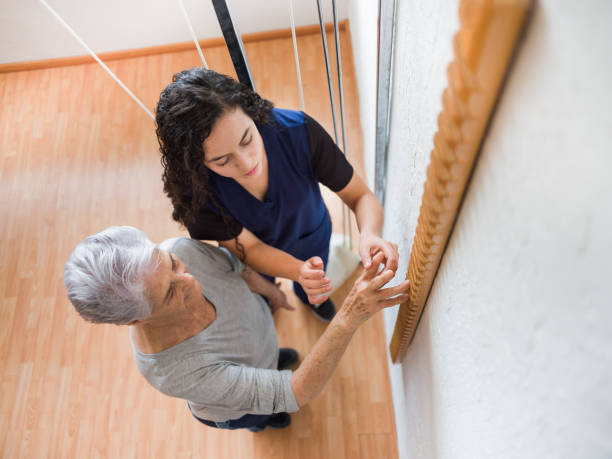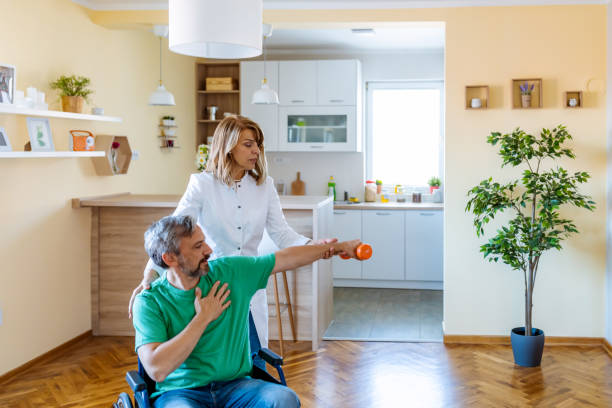Introduction

Living with Parkinson's disease presents unique challenges for individuals diagnosed with the condition and their loved ones. As the disease progresses, it can lead to difficulties with movement, balance, and coordination, making everyday activities more challenging, including navigating within the home.
Nevertheless, armed with the appropriate adaptations and aids, it is entirely within reach to forge a safer and more accommodating environment that nurtures independence and enhances the overall fabric of life for individuals grappling with Parkinson's through thoughtful home modifications and the integration of supportive aids, a transformative realm emerges, one that fosters a sense of security and empowers individuals to navigate their surroundings with newfound confidence. By embracing these measures, we unlock a realm where independence thrives, enabling individuals to embrace life's journey with a restarted sense of purpose and a heightened quality of life.
This blog post will explore the best home modification aids to enhance safety for individuals with Parkinson's disease. From simple adjustments to specialized equipment, we will delve into practical solutions that minimize risks and facilitate daily activities. Whether you find yourself in the role of a caregiver, a concerned family member, or an individual navigating the challenges of Parkinson's disease, this comprehensive guide unveils a trove of invaluable insights and recommendations to transform your home into a nurturing haven of support and security.
Best Home Modification Aids for Parkinson's Disease Patients

Regarding living with Parkinson's disease, safety should be your number one priority. There are a variety of home modification aids and strategies available that can help increase the safety of those with Parkinson's in their homes. Here are some of our top recommendations for enhancing safety at home:
Non-slip bath mats
The bathroom is one of the most accident-prone areas in a home. Non-slip bath mats provide an essential layer of protection by preventing slips and fall. These bathmats feature anti-slip surfaces that offer stability and reduce the risk of accidents. When choosing non-slip bath mats, looking for materials that provide good traction and are easy to clean is important.
Handguards
Handguards, also known as handrails or grab rails, are essential aids for enhancing safety and stability throughout the home. They provide support when navigating stairs, hallways, or any area where balance is required. Handguards come in various types, including wall-mounted rails and floor-to-ceiling poles. Choosing sturdy handguards, easy to grip and installed at the appropriate height is important.
Ramps
Ramps are crucial for improving accessibility and mobility within the home. They enable individuals with Parkinson's disease who use mobility aids or have difficulty with stairs to move around more easily. Ramps can be installed at entrances, thresholds, or any other area where elevation changes exist. Different types of ramps are available, such as modular and portable. The best ramps for Parkinson's patients are those that provide stability, have a non-slip surface, and meet the specific needs of the individual.
Reaching aids
Parkinson's disease can cause difficulties in reaching and grabbing objects. Reaching aids are designed to extend an individual's reach, making it easier to access items without straining or risking a fall. These aids come in various forms, including reaches and grabbers with adjustable handles and gripping mechanisms. W
In the process of choosing reaching aids, it is essential to take into account factors such as length, weight capacity, and ease of use.
Extra lighting
Inadequate lighting can contribute to accidents and falls, particularly for individuals with Parkinson's disease. Extra lighting fixtures can greatly enhance safety by improving visibility in key areas of the home. Installing motion-activated lights or increasing the wattage of existing bulbs can make a significant difference. Additionally, nightlights can be strategically placed to provide illumination during nighttime. Ensuring proper lighting in hallways, staircases, and frequently used areas is essential to minimize the risk of accidents.
Toilet risers
Using the toilet can become challenging for Parkinson's patients due to limited mobility and balance issues. Toilet risers are designed to elevate the seat, making it easier to sit down and stand up. These aids are available in different heights and designs to accommodate individual needs. Choosing toilet risers that are stable, easy to install, and compatible with the existing toilet is important.
Tub transfer benches
Entering and exiting the bathtub can pose significant risks for individuals with Parkinson's disease. Tub transfer benches provide a safe and convenient solution by allowing individuals to sit securely while moving in and out of the tub. These benches typically feature a sturdy frame with adjustable height and a non-slip seat. Selecting a tub transfer bench that fits the bathtub dimensions and provides adequate support is crucial.
Wider doorways
For individuals with mobility aids, such as wheelchairs or walkers, wider doorways are essential for easy passage. Modifying doorways to increase their width ensures unobstructed movement and independence. Widening doorways requires professional assistance, and it's important to consult with experts who specialize in home modifications. By widening doorways, individuals with Parkinson's disease can easily navigate their homes and reduce the risk of accidents.
Lever handles
Traditional doorknobs can be challenging for Parkinson's patients to operate due to limited dexterity and motor control. Lever handles offer a more accessible alternative, allowing individuals to open doors with minimal effort. Lever handles are available in various designs and finishes to complement the home décor. When choosing lever handles, it's important to consider the ease of use, durability, and compatibility with existing doors.
Grab bars
Grab bars enhance safety and prevent falls in key home areas, such as bathrooms and hallways. These bars provide stability and support when standing, sitting, or moving around. Grab bars should be strategically placed where individuals with Parkinson's disease may require assistance, such as near toilets, showers, and stairs. Choosing grab bars that are sturdy, securely installed, and capable of supporting the individual's weight is important.
What are the home modifications for Parkinson's patients?

Home modifications for Parkinson's patients include reaching aids, extra lighting, toilet risers, tub transfer benches, wider doorways, lever handles, and grab bars. Reaching aids help individuals with mobility issues to reach items without straining or risking a fall.
Additionally, extra lighting fixtures can improve visibility in key areas of the home, while toilet risers and tub transfer benches provide a safe way to sit down and stand up. Wider doorways ensure unobstructed movement and independence, while lever handles provide an accessible alternative to traditional doorknobs.
Finally, grab bars can be strategically placed where assistance is often needed, such as near toilets, showers, and stairs. These modifications can increase safety and reduce the risk of accidents for individuals with Parkinson's disease. It is important to consult a home specialist to ensure all measures are properly installed, and the correct aids are chosen to meet the individual's needs. With the right modifications, an environment can be created where Parkinson's patients can live safely and independently.
What are the best tools for Parkinson's patients?
Various tools are available to help people with Parkinson's manage their symptoms. These include physical therapy, medications, and assistive technology such as tailored exercise programs and voice-activated devices.
Physical therapy focuses on strengthening the body's muscles through stretching and exercises designed to improve balance and coordination. Physical therapists can help design a tailored program to meet the individual's needs and keep them motivated.
Medications can help manage the physical symptoms of Parkinson's by targeting areas such as tremors, stiffness, and coordination. Several different classes of medications are available depending on an individual's circumstances.
Assistive technology can also help manage Parkinson's symptoms, such as voice-activated devices and tailored exercise programs. Voice-activated devices allow people with Parkinson's to control their environment without difficulty. Tailored exercise programs can provide an individualized plan for improving balance and coordination, which is essential for daily functioning.
Conclusion
We trust that this article has furnished you with valuable insights regarding home modifications and tools tailored for individuals with Parkinson's. By implementing home adaptations, we can foster a safer and more comfortable environment while integrating assistive technology can effectively manage symptoms and enhance the overall quality of life. It is crucial to seek guidance from a specialist when contemplating any alterations to your home, ensuring that every measure is properly installed and specific needs are thoughtfully addressed. With the right modifications and tools, individuals with Parkinson's can confidently embark on a journey of safe and independent living within the comforts of their own homes.
FAQs
Can these home modification aids be useful for other mobility limitations?
Absolutely! While these aids are specifically mentioned for Parkinson's patients, they can also benefit individuals with other mobility limitations or conditions affecting balance and coordination.
Where can I purchase these home modification aids?
You can find these aids at medical supply stores, specialized home modification retailers, and online platforms. Make sure to research reputable suppliers and check customer reviews before purchasing.
How much does it cost to modify a home for Parkinson's patients?
The cost of home modifications can vary depending on the specific requirements and the extent of modifications needed. It's recommended to consult with professionals specializing in home modifications for an accurate assessment and cost estimation.
Are there any government programs or assistance available for home modifications?
In some countries, government programs, grants, or assistance may be available for home modifications to improve accessibility and safety for individuals with disabilities. Researching local government resources or consulting with relevant organizations for information on available programs is advisable.
How often should these home modification aids be inspected for safety?
Regular inspections play a pivotal role in safeguarding the continual safety and optimal functionality of home modification aids. It is highly recommended to conduct periodic inspections, diligently examining these aids for any indications of wear, damage, or lose fittings. By prioritizing the maintenance and upkeep of these aids, we ensure a secure and reliable environment that promotes the well-being and independence of individuals.

